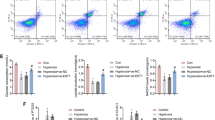Summary
To investigate the protective effect of retinoic acid (RA) on hyperoxic lung injury and the role of RA as a modulator on mitogen-activated protein kinases (MAPKs), gastation 21 d Sprague-Dawley (SD) fetuses (term=22 d) were delivered by hysterotomy. Within 12–24 h of birth, premature rat pups were randomly divided into 4 groups (n=12 each): air-exposed control group (group I); hyperoxia-exposed group (group II), air-exposed plus RA group (group III), hyperoxia-exposed plus RA group (group IV). Group I, III were kept in room air, and group II, IV were placed in 85% oxygen. The pups in groups III and IV were intraperitoneally injected with RA (500 μg/kg every day). All lung tissues of premature rat pups were collected at the 4th day after birth. Terminal transferase d-UTP nick end labeling (TUNEL) staining was used for the detection of cell apoptosis. The expression of PCNA was immunohistochemically detected. Western blot analysis was employed for the determination of phosphorylated and total nonphosphorylated ERKs, JNKs or p38. Our results showed that lungs from the pups exposed to hyperoxia for 4 d exhibited TUNEL-positive nuclei increased markedly throughout the parenchyma (P<0.01), and decreased significantly after RA treatment (P<0.01). The index of PCNA-positive cells was significantly decreased (P<0.01), and was significantly increased by RA treatment (P<0.01). The air-space size was significantly enlarged, secondary crests were markedly decreased in hyperoxia-exposed animals. RA treatment improved lung air spaces and secondary crests in air-exposed pups, but had no effect on hyperoxia-exposure pups. Western blotting showed that the amounts of JNK, p38 and ERK proteins in hyperoxia-exposure or RA-treated lung tissues were same as those in untreated lung tissues (P>0.05), whereas activation of these MAPKs was markedly altered by hyperoxia and RA. After hyperoxia exposure, p-ERK1/2, p-JNK1/2 and p-p38 were dramatically increased (P<0.01), whereas p-JNK1/2 and p-p38 were markedly declined and p-ERK1/2 was further elevated by RA treatment (P<0.01). It is concluded that RA could decrease cell apoptosis and stimulate cell proliferation under hyperoxic condition. The protection of RA on hyperoxia-induced lung injury was related to the regulation of MAP kinase activation.
Similar content being viewed by others
References
Saugstad O D. Bronchopulmonary dysplasia and oxidative stress: are we closer to an understanding of the pathogenesis of BPD? Acta Paediatr, 1997, 86 (12): 1277–1282
Carvalho H, Evelson P, Sigaud Set al. Mitogen-activated protein kinases modulate H2O2-induced apoptosis in primary rat alveolar epithelial cells. J Cell Biochem, 2004, 92: 502–513
Kling D E, Lorenzol H K, Trbovichl A Met al. Pre-and postnatal lung development, maturation, and plasticity MEK-1/2 inhibition reduces branching morphogenesis and causes mesenchymal cell apoptosis in fetal rat lungs. Am J Physiol Lung Cell Mol Physiol, 2002, 282: L370-L378
Ozer E A, Kumral A, Ozer Eet al. Effect of retinoic acid on oxygen-induced lung injury in the newborn rat. Pediatr Pulmonol, 2005, 39: 35–40
Chang L W, Rong Z H, Zhang Q S. Effect of retinoic acid on lung injury in hyperoxia-exposed newborn rats. J Huazhong Univ Sci Technol [Med Sci], 2003, 23 (1): 71–74
Bui K C, Buckley S, Wu Fet al. Induction of A-and D-type cyclins and cdc2 kinase activity during recovery from short-term hyperoxic lung injury. Am J Physiol Lung Cell Mol Physiol, 1995, 268(12): L625-L635
Veness-Meehan K A, Pierce R A, Moats-Staats B Met al. Retinoic acid attenuates O2-induced inhibition of lung septation. Am J Physiol Lung Cell Mol Physiol, 2002, 283: L971-L980
Pierce R A, Shipley J M. Retinoid-enhanced alveolization identifying relevant downstream Targets. Am J Respir Cell Mol Biol, 2000, 23: 137–141
Massaro D, Massaro G C. Retinoids, alveolus formation, and alveolar deficiency. Am J Respir Cell Mol Bio, 2003, 28: 271–274
Palm-Leis A, Singh U S, Herbelin B Set al. Mitogenactivated protein kinases and mitogen-activated protein kinase phosphatases mediate the inhibitory effects of all-trans retinoic acid on the hypertrophic growth of cardiomyocytes. J Biol Chem, 2004, 279(52): 54905–54917
Crowe D L, Kim R, Chandraratna R A. Retinoic acid differentially regulates cancer cell proliferation via dose-dependent modulation of the mitogen activated protein kinase pathway. Mol Cancer Res, 2003, 1: 532–540
Author information
Authors and Affiliations
Additional information
LI Wenbin, male, born in 1971, M.D., Ph.D.
This project was supported by a grant from the National Key Science and Technology Program of the Tenth Five-years-Plan (No. 2004BA720A11), and a grant from National Natural Sciences Foundation of China (No. 30471824).
Rights and permissions
About this article
Cite this article
Wenbin, L., Liwen, C., Zhihui, R. et al. Mechanism of retinoic acid and mitogen-activated protein kinases regulating hyperoxia lung injury. J. Huazhong Univ. Sci. Technol. [Med. Sci.] 26, 178–181 (2006). https://doi.org/10.1007/BF02895809
Received:
Issue Date:
DOI: https://doi.org/10.1007/BF02895809




